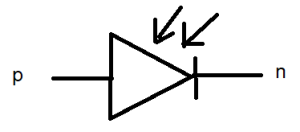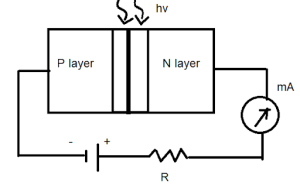Introduction
Photodiodes are the special type of semiconductor diodes that convert electrical energy into light energy when exposed to light.
When the junction of the photodiode is illuminated, then the electric current flows through the two terminals. Only electrons flow through it in reverse bias. This is called the photoelectric effect.

Symbol of photodiode
Construction of photodiode
The PN junction of the photodiode is placed inside a glass. This transparent glass allows sunlight to pass through the diode. The other side of the glass is insulated.

Internal construction of Photodiode
Working of photodiode
When the photodiode is not exposed to light or radiation, the electrons in the p side flow through the junction. As the minority carriers are flowing through the junction, there will be a flow of reverse current. This current is called dark current.
When the photodiode is exposed to light, the temperature of the junction will increase. The electrons and holes will get separated from each other. The electrons, which are on the n side will get attracted towards the positive terminal of the battery and the holes, which are on the p side will get attracted to the (-) terminal of the battery.
As a result of this, a high amount of reverse current gets generated through the junction. When the light intensity increases, more carriers are generated and flow through the photodiodes. Hence, a large current is produced.
The light intensity is directly proportional to the electric current.
Applications of photodiodes
- Photodiodes are used in burglar alarms.
- Photodiodes are used in counters and switching circuits.
- It helps to communicate in the optical system.
- It is used in logic circuits and encoders.
Solar cell
A solar cell is an electrical device in which light energy gets converted into electrical energy by the photovoltaic effect. It is basically a PN junction diode and is called a photovoltaic cell. The solar panel is formed by a combination of solar cells. The common junction will produce a maximum voltage of 0.5 to 0.6 volts. Large solar panels can produce a large amount of renewable energy.
The solar cells are basically made up of materials like Gallium arsenide, Cadmium Tetride, and Silicon.
Diode construction
The solar cell is a junction diode, which contains a very thin layer of p-type semiconductor with the thicker n-type semiconductor. The PN junction layer can be found just below the p-layer.
Working of solar cell
When light is exposed to the PN junction, the light photons will enter into the junction through the p-layer. The light energy produces enough energy to create the electron-hole pairs. It is based on the breakage of the thermal equilibrium condition of the junction. The free electrons in the depletion move to the n-type side of the PN junction.
And the holes move to the p-side of the junction. The concentration of the electrons and holes will increase on both the n and p type of the junction. It will behave like a battery cell. The voltage generated is called photovoltage.
Applications of solar cell
- Used for battery charging
- Used in watches and calculators.
- Used in light metres
- Provide electrical energy to spacecraft.
Laser diode
A laser diode is a special type of semiconductor diode that produces coherent laser light. This light wave has the same frequency and phase. This phenomenon is called Light Amplification by Stimulated Emission Of Radiation (LASER). As it is producing laser light, it is called laser diodes.
Construction Of laser diode
The laser diode is made up of P-type material, N-type material, and Metal contact.
The metal plate is placed between the n and p type layers. This is called a homojunction laser diode. The region used to increase the volume of active regions is called the intrinsic or active region. As a result of this, the holes and electrons get accumulated at the junction.
Types of laser diode
There are several types of laser diodes such as
- Double heterostructure laser diode
- Separate confinement hetero-structure laser diode
- Quantum cascade laser diode
Working of laser diode
As the current increases, the optical power of the output light increases up to the threshold. Here, the light is emitted by spontaneous emission. The power output is directly proportional to the input current.
Applications of laser diode
- Used in laser printers
- Used in medical types of equipment
- Used in scientific instruments
- Used for cutting of materials
Conclusion
In this article, we have seen the special types of semiconductor diodes like photodiodes, solar cells and laser diodes. These semiconductor diodes are used for many applications in the electronic world. We have also covered the solar cell and laser diode. Semiconductors play a significant role in our daily life. Semiconductor material has conductivity less than conductor but higher than an insulator. Using semiconductors we can form various types of diodes such as PN junction diode, zener diode, light emitting diode (LED), photodiode etc.
 Profile
Profile Settings
Settings Refer your friends
Refer your friends Sign out
Sign out






